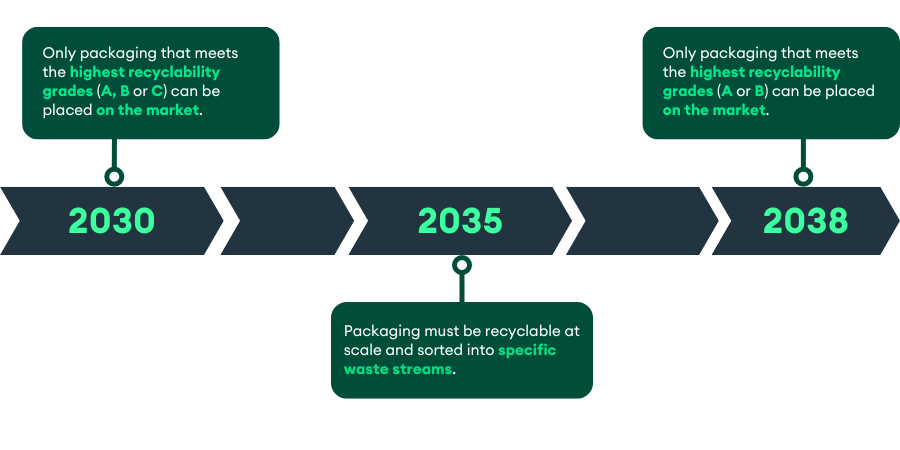Part 1 | Understanding the PPWR Regulation: Sustainability criteria

The Packaging & Packaging Waste Regulation (PPWR) impacts all packaging types and packaging waste, whether from industrial, commercial, or household sources and sets requirements for the entire life cycle of packaging including comprehensive requirements for packaging sustainability and labelling.
In this article, we aim to give you a first overview on the upcoming sustainability and labelling requirements.
Sustainability and labelling criteria for packaging
Minimising substances of concern
The presence of harmful substances must be kept to a minimum in packaging, and the regulation defines maximum levels for the following substances of concern:
- The sum concentration levels of lead, cadmium, mercury and hexavalent chromium in packaging components must not exceed 100 mg/kg.
- Food contact packaging must not contain per- and polyfluorinated alkyl substances (PFAS) above specified limits.
Recyclability
All packaging must be recyclable. Packaging must be designed for material recycling to produce high-quality secondary raw materials. Specific design for recycling criteria will be established, introducing performance grades A, B and C.

Recycled content
Specific targets for recycled content in plastic packaging will be enforced:
Bio-based feedstock and compostable packaging
Technological developments and the environmental performance of bio-based packaging will first be reviewed in order to define sustainability criteria for such packaging.
Permeable tea and coffee bags or individual flexible pods containing tea, coffee or another beverage, as well as sticky labels for fruit and vegetables, must be compostable in industrial controlled conditions.
Packaging waste made from biodegradable materials must support material recycling without compromising the quality of existing waste streams.
Packaging minimisation and excessive packaging
Packaging minimisation:
Packaging must be designed to minimise weight and volume while maintaining functionality. Regulation prohibits features that falsely increase perceived volume, such as double walls and false bottoms.
Excessive packaging:
- Grouped packaging, transport packaging and e-commerce packaging: an empty space rate is introduced, which must not exceed 50%.
- Sales packaging: empty space must be reduced to the minimum necessary to ensure packaging functionality.
Space filled with filling materials, such as paper cuttings, air cushions, bubble wraps, sponge fillers, foam fillers, wood wool, polystyrene or Styrofoam chips, is considered as empty space.
Reusable packaging
Reusable packaging must meet the following criteria:
- Is designed for multiple rotations. Secondary legislation will set the minimum number of rotations.
- Meets consumer health, safety and hygiene requirements
- Is recyclable
Labelling requirements
The PPWR introduces harmonised labelling, marking requirements and sorting instructions to facilitate sorting and inform consumers. For example, labels must indicate material composition.
These labelling requirements will be accompanied by harmonised labelling of waste receptacles for the collection of packaging waste.
Current status and next steps
The PPWR was recently adopted by the European Parliament, but it is not in force yet. It still needs to be adopted by the Commission and the Council, and the exact timeline for its implementation is not yet known. We will continue to provide updates and guidance to help you navigate these changes. Keep an eye on our communications to stay informed on the latest developments.
Don’t miss our next newsletter, where we will discuss the packaging waste prevention measures in the PPWR. Subscribe to our newsletters via this form.
Your Valorlux Team
